There are over 300 UX agencies in London. That’s… a lot of polished portfolios to scroll through.
From boutique studios in Shoreditch to enterprise consultancies in Soho, the scene is full of talent. The problem? Everyone looks great on paper. Everyone says they’re “human-centered,” “award-winning,” and “lean.”
But you’re not here to read adjectives. You’re here to find the right partner, one that fits your project, your team, and your budget.
This guide is for marketing managers, product owners, and startup founders who want a clear, no-nonsense breakdown of the best UX agencies in London. Let’s start with the shortlist.
1. Eleken
.png)
Eleken is a UX/UI design agency with a distributed team originating in Kyiv, Ukraine, and working closely with SaaS teams across London, the UK, and Europe. With 100+ product designers, Eleken has completed 200+ projects and published 64+ case studies, mostly for complex B2B SaaS, AI, data, geospatial, and no-code/low-code products.
Their async setup works surprisingly well across time zones, and their clients say the same thing: “It feels like we have an in-house designer, just faster.”
Services: UX/UI design for SaaS, UX audit, product flows, onboarding UX, dashboards, design systems.
Budget fit: Monthly flat subscription, full-time from $5,999/month, with flexible part-time options, no hourly guessing, and no add-on fees.
Collaboration style: Remote + async-first, embedded designers with direct access via Slack, Figma, Loom, etc.
Team size: 100+ SaaS product designers.
If you’re building a B2B platform, trying to get your MVP investor-ready, or scaling UX across a growing product, they’ve done it. And they’ve done it without bloated timelines, kickoff docs, or layers of strategy-speak.
You get a senior product designer embedded in your team. No project managers. Just clean, user-friendly UX, shipped fast.
What clients say
Eleken is trusted by teams at Advan Research, Prift, Datawisp, Frontend AI, and Habstash, with a 4.9-star rating on Clutch and over 111+ reviews from SaaS founders and product managers.

Clients praise their quality and speed, their ownership mindset, their ability to transform complex specs into intuitive flows, and their measurable impact on product metrics. For example, clients like Floret, Datawisp, and Aampe went on to raise multi-million funding rounds with products Eleken helped design, while Zaplify doubled activation rates with better guided funnels.

Want to understand what remote UX designers do? Watch this:
Strong points
✔️ SaaS-only focus, deep experience with dashboards, data-heavy UX, and onboarding flows.
✔️ The top 1% of designers, vetting for UX skills, fluent English, critical thinking, and clear communication.
✔️ 3-Month UX Bootcamp: every designer goes through an internal bootcamp to learn Eleken’s UX standards, patterns for data-heavy products, and the process for working with dev teams.
✔️ Free design trial, try before you commit (rare in this space).
Weak points
- No in-house development. Eleken is design-only, so you’ll need dev support ready.
- Not the best fit if you just need a marketing website with no product behind it.
What makes them different:
- Subscription pricing = no surprises.
- Designers don’t get swapped mid-project.
- Design handoff is dev-friendly: UI kits, design systems, and states are documented so London-based dev teams can ship faster.
2. Studio Graphene
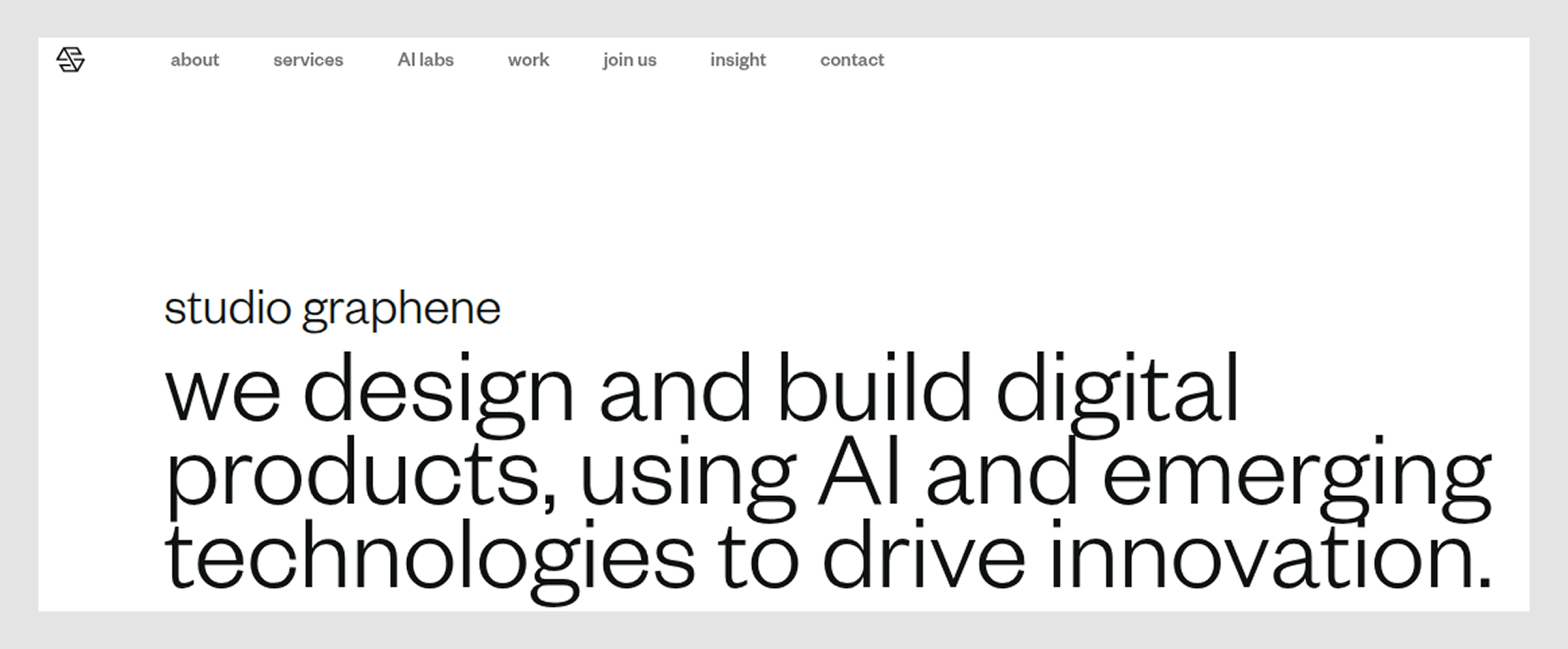
If you’re building something techy, new, and maybe a little weird, Studio Graphene might be your people.
Based in Shoreditch, this agency focuses on “emerging tech” projects; think IoT apps, AI interfaces, and digital products that don’t quite fit into neat categories.
Services: UX/UI design, product strategy, rapid prototyping, mobile + web design and development, branding, brand identity.
Budget fit: ~£10K+ project minimum. Mid-range hourly rates depending on scope.
Collaboration style: Flexible, a hybrid of in-person (London HQ) and remote collaboration. Known for fast prototyping cycles and co-creation workshops.
Team size: 60+ designers, developers, and strategists.
This UI UX design agency is a good fit if you're launching something experimental and need a team that won’t blink at complex requirements or fuzzy product-market fit.
They combine product strategy, UX/UI design, and development under one roof, which is helpful if you’re looking for an end-to-end partner rather than managing multiple vendors.
What clients say
Studio Graphene has helped build products for Drive Fuze, Harth, Cypher, and dozens of early-stage startups, earning a 4.7-star rating on Clutch.
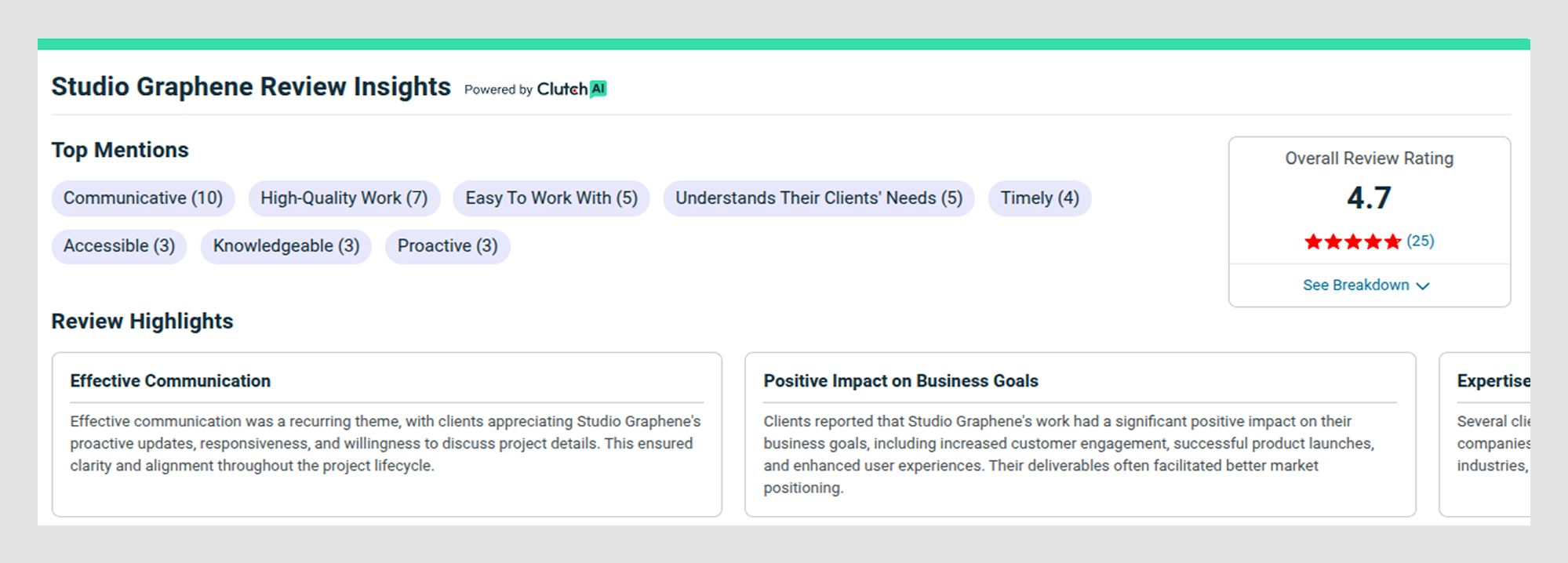
Clients often cite their ability to move quickly and client-first approach without skipping the thinking phase, a sweet spot for teams who want polish but can’t afford to slow down.

Strong points
✔️ Great for MVPs and experimental tech.
✔️ Offers full-stack support (design + development).
✔️ London-based, available for in-person sessions.
✔️ Startup-friendly, but structured enough for scale-ups.
Weak points
– May be overkill if you just need design (not dev or strategy).
– Can be pricier than solo or boutique designers.
What makes them different
- Focus on emerging technologies: AI, blockchain, IoT.
- Ability to take vague product ideas and shape them into something launchable.
- Solid process without crushing your timeline.
3. Browser London
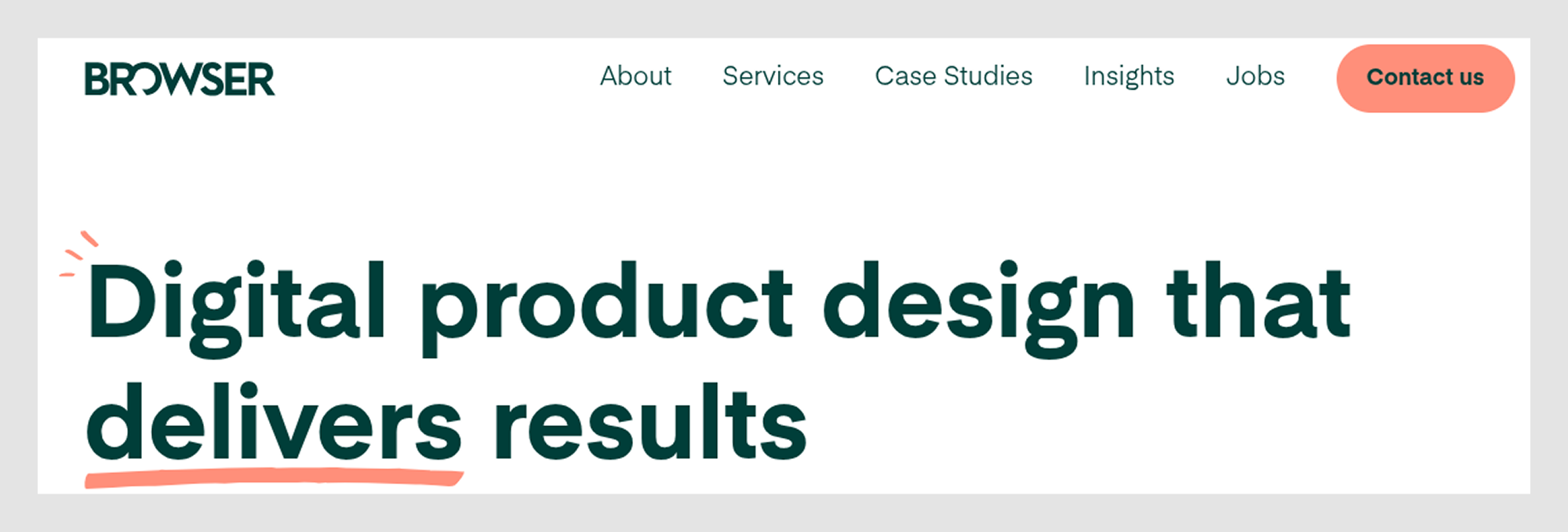
Browser London both designs nice interfaces and makes sure your users can use them.
This UX/UI design agency London is research-first, accessibility-conscious, and proudly low-ego. Their work often sits behind government services, nonprofit platforms, and purpose-driven digital tools. If you're looking for an agency that obsesses over clarity, inclusion, and real-world usability, this is one to shortlist.
Services: User research, UX/UI design, service design, accessibility audits, digital strategy.
Budget fit: ~£20K+ project minimum. Day rates and retainers available.
Collaboration style: In-person friendly (London HQ) with strong remote capabilities. Workshops, interviews, and testing are baked into every phase.
Team size: 25+ researchers, designers, and strategists.
Browser’s team goes deep into user needs before touching a wireframe. Their process is methodical but collaborative, making them a strong fit for organizations with complex user bases or public-facing responsibilities.
What clients say
Clients include The Catapult Network, Preact Technology, and First Quantum Minerals. The company holds a Clutch rating.
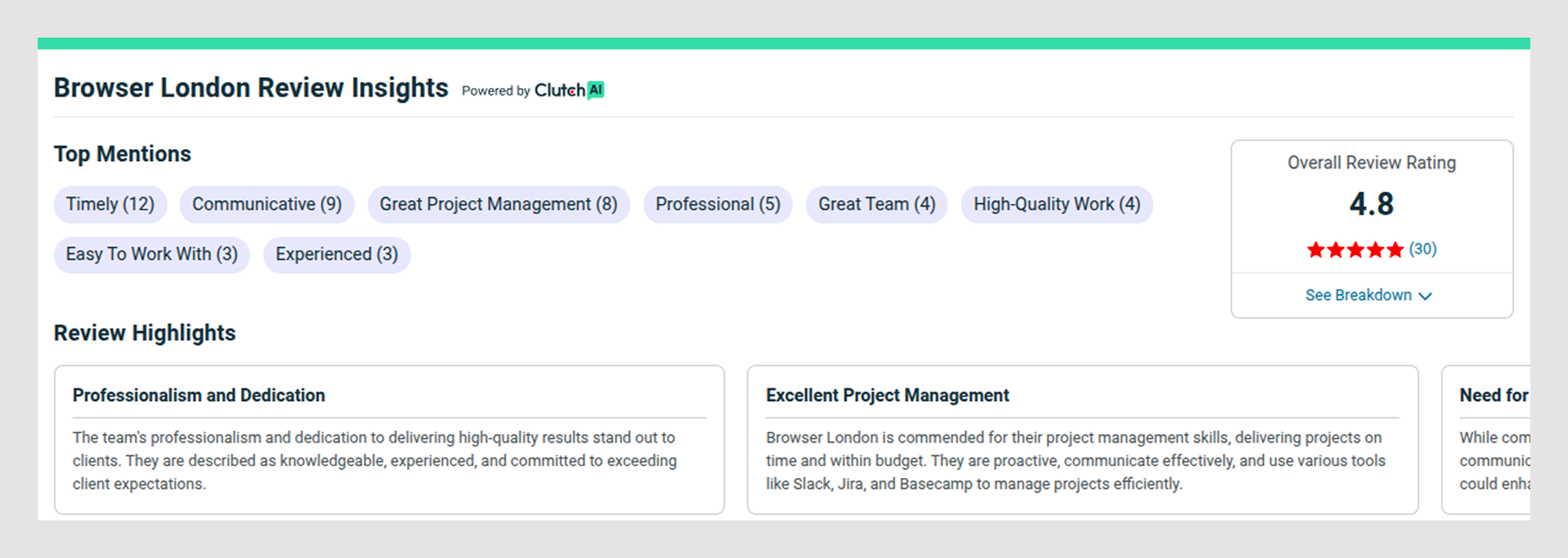
They’re praised for thoughtful, accessible design and their ability to work across messy stakeholder environments without losing momentum.

Strong points
✔️ Deep research capabilities.
✔️ Accessibility isn’t an afterthought; it’s baked in.
✔️ Ideal for government, nonprofit, or multi-audience services.
✔️ Calm, collaborative, no-BS team.
Weak points
– Not built for fast-moving MVPs or visual-first marketing sites.
– Strategy-heavy approach may be too slow for early-stage startups.
What makes them different
- Strong alignment with ethical design and digital inclusion.
- Experience with large systems and real-world constraints.
- Human-centered without the buzzwords.
4. Catch
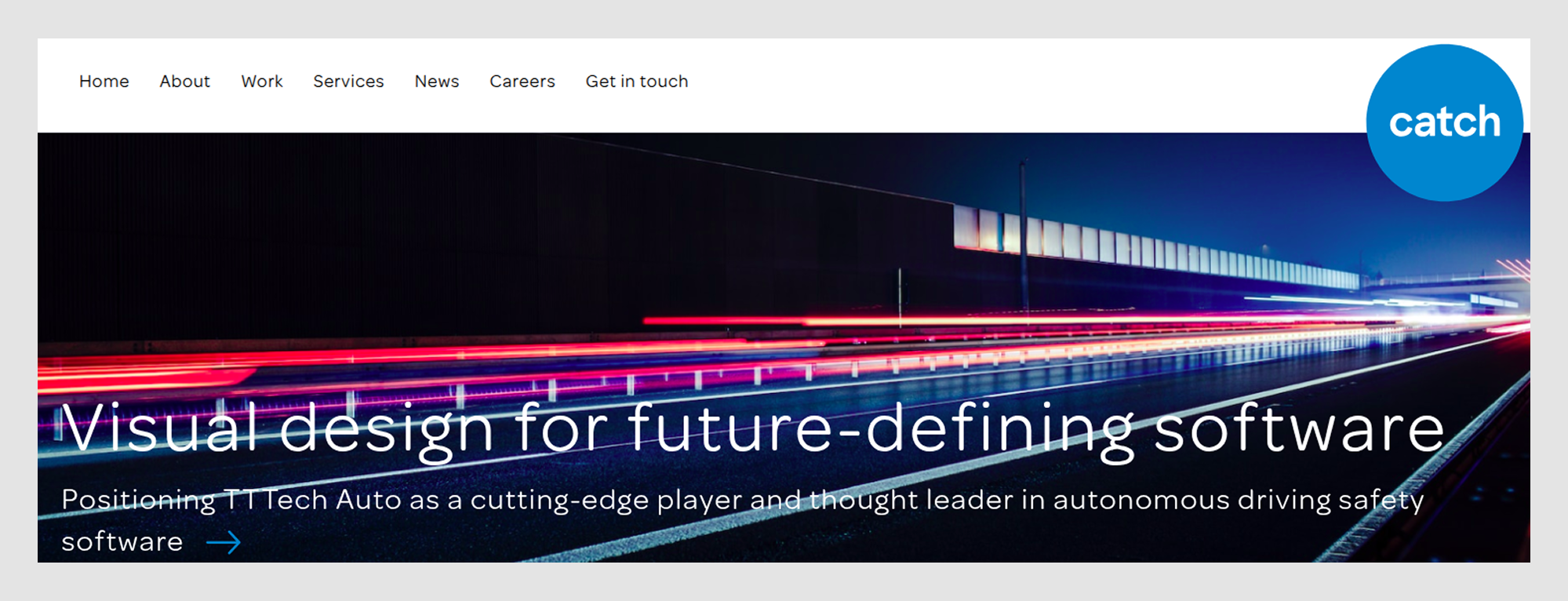
Catch is what happens when a UX team and a CRO agency have a very productive meeting.
They’re known for sleek UX that doesn’t just look good; it performs. Based in London, Catch collaborates with companies in the travel, education, and lifestyle sectors to create websites and products that convert users without overwhelming them.
Services: UX/UI design, conversion rate optimization (CRO), user testing, digital strategy, WordPress, and custom builds.
Budget fit: ~£10–15K project minimum. Mid-range for London, depending on scope.
Collaboration style: Hybrid, happy to meet in person, but most projects run smoothly remotely. Emphasis on fast cycles and measurable design outcomes.
Team size: ~20 strategists, designers, and developers.
These UX design experts are good at simplifying complex user journeys. Whether it’s booking a trip or completing an onboarding flow, Catch builds with friction in mind and removes it.
What clients say
They’ve worked with Oracle, Thomas Cook Airlines, Sharp, and the University of Salford. Their Clutch rating is 4.6.
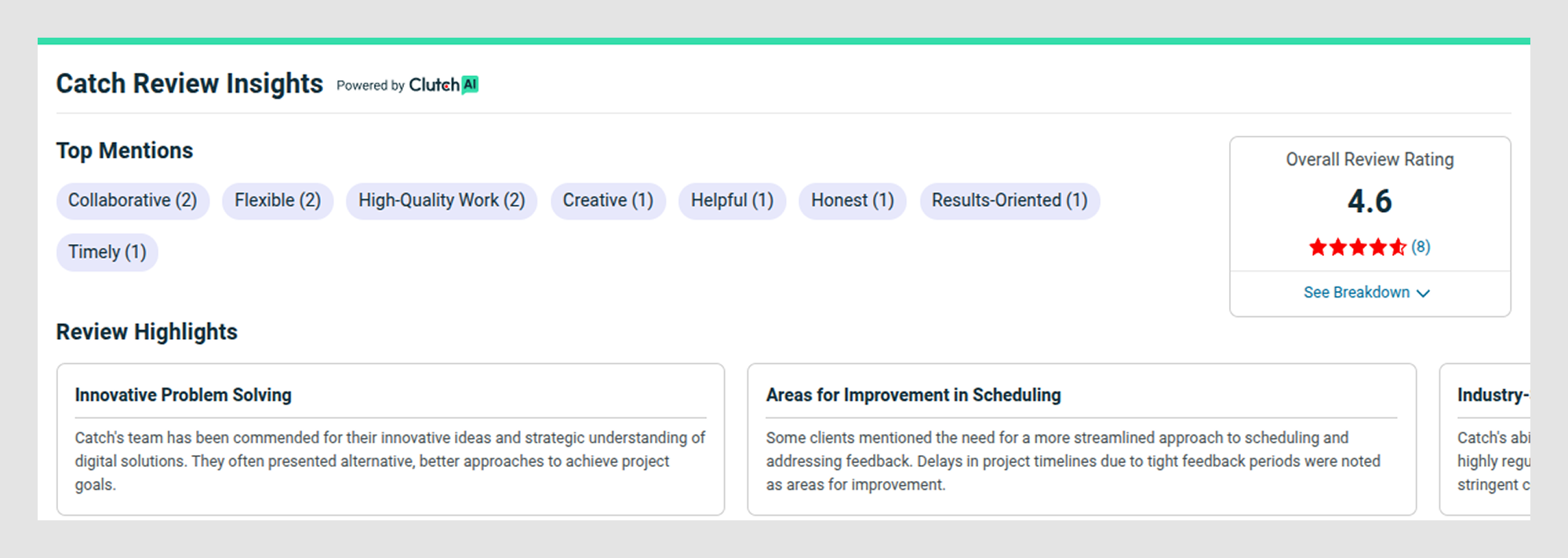
Clients highlight their ability to translate business goals into frictionless user flows, without overcomplicating the process. They adapt quickly and are often seen as a good “bridge” between digital marketing and product teams.

Strong points
✔️ Strong UX/CRO overlap, ideal for growth teams.
✔️ Fast and focused, not precious about iterations.
✔️ Great track record in travel, education, and services.
✔️ Solid dev support if you want to launch fast.
Weak points
– Not as strong on deep research or strategy-heavy projects.
– More executional than conceptual, which could be a pro or con depending on your needs.
What makes them different
- UX with conversion baked in, good for teams focused on outcomes.
- Built for speed and iteration, not endless workshops.
- Particularly useful for website redesigns of high-traffic web experiences.
5. Lighthouse

If your product is a bit of a mess (no judgment), Lighthouse (now part of Digital Product People) is the team you call to untangle it.
They specialize in product discovery, UX audits, and redesigns, especially for companies that have already launched but know something’s not working.
Services: UX strategy, product discovery, UX/UI design, usability testing, design systems.
Budget fit: ~£20K–£50K+. Mid-to-upper range, depending on depth of discovery and redesign.
Collaboration style: In-house style, they embed into your team and work side-by-side. Available for in-person workshops in London.
Team size: ~15 UX strategists, researchers, and UI designers.
Lighthouse is based in London and works closely with internal teams to figure out what users need, not just what stakeholders assume they want.
Their vibe is collaborative, not prescriptive. Think fewer “big reveal” decks, more working sessions, and iterative testing.
What clients say
Lighthouse has partnered with brands like PayPoint, Roche, and Red Bull, as well as numerous scale-ups and B2B platforms, and holds a perfect 5-star rating on Clutch.
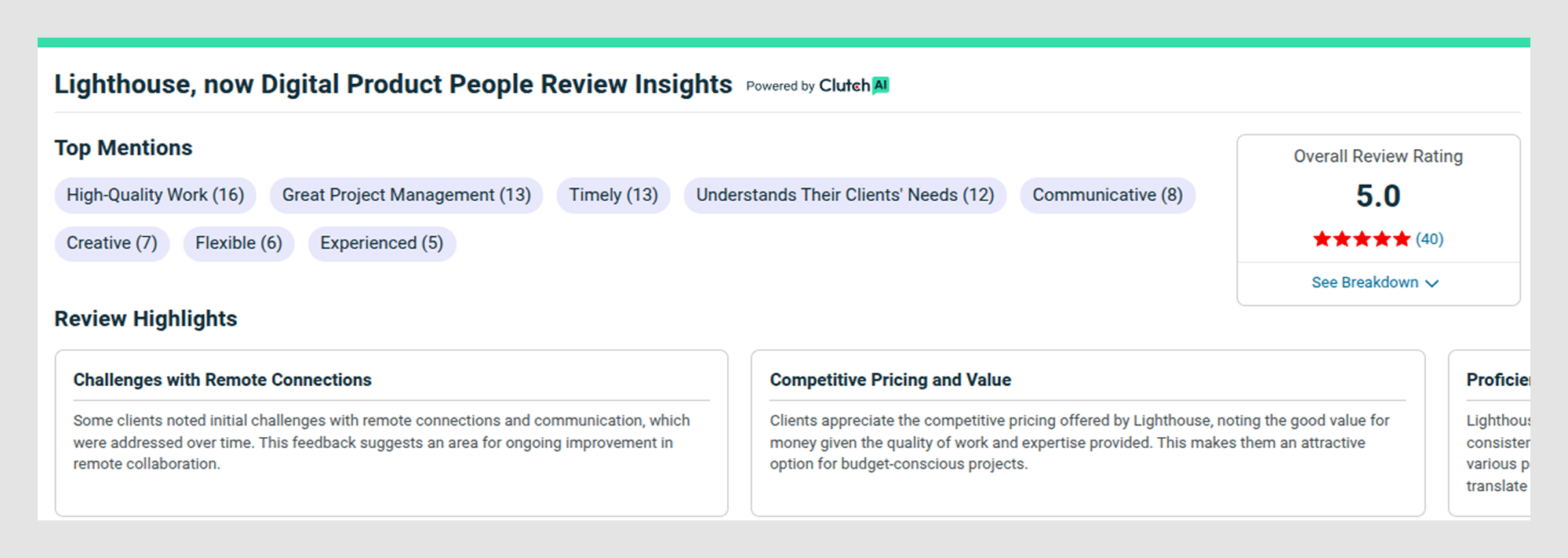
They’re praised for their supportive, calm, thoughtful approach to complex design challenges, especially in legacy UX that requires a reset, not a rebrand.

Strong points
✔️ Experts at UX audits and problem framing.
✔️ Embedded model, expect close collaboration.
✔️ Ideal for complex or “mature-but-clunky” products.
✔️ Research-led but not rigid.
Weak points
– May not be the fastest if you're looking to ship an MVP in 4 weeks.
– More process-heavy than plug-and-play agencies.
What makes them different
- They love messy products and they’re good at fixing them.
- They don’t just polish interfaces, they rebuild UX from the logic up.
- Great for mid-sized companies with some UX maturity (and a few skeletons).
6. Make It Clear
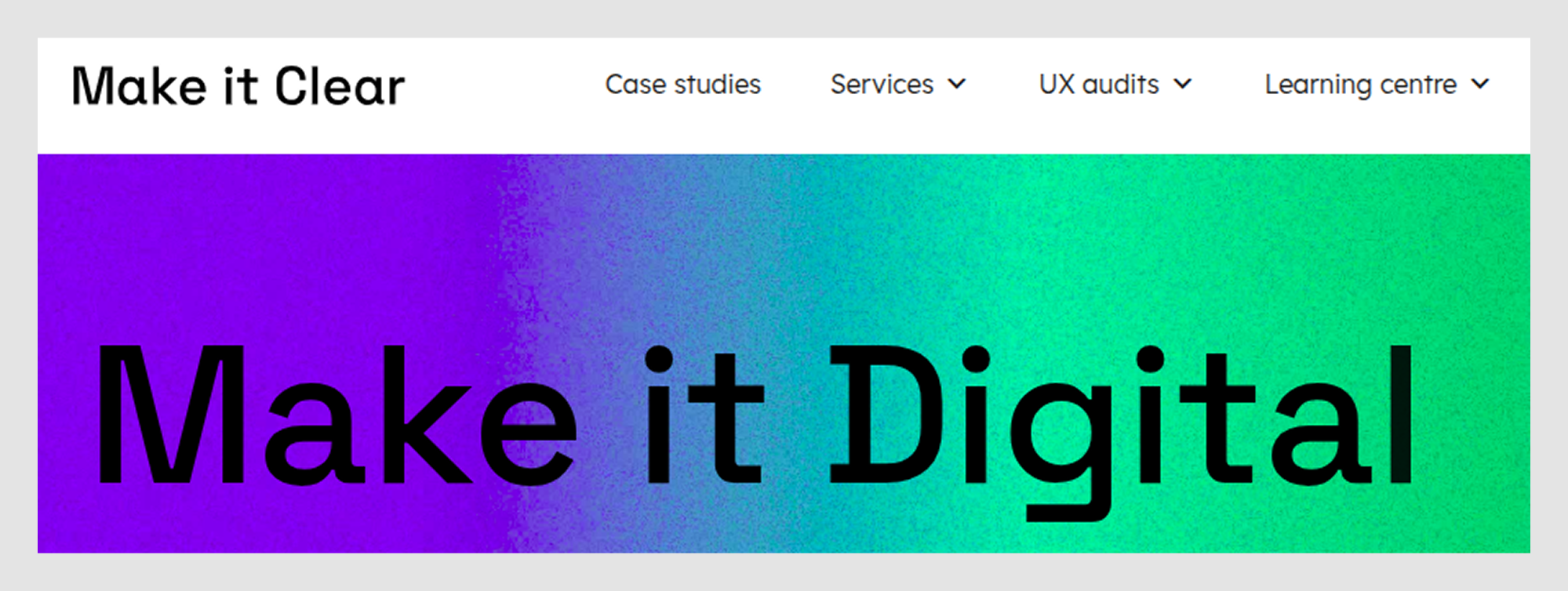
Make it Clear is exactly what it sounds like: a user experience agency London that turns complex information into clear, user-friendly experiences.
They’ve been doing this for over 20 years, primarily serving clients in the tech, education, government, and healthcare sectors. Based in London, they bring a strategic lens to UX, starting with research and ending with design that feels almost obvious.
Services: UX research, service design, UX/UI design, content design, strategy workshops.
Budget fit: ~£15K–£50K depending on scope. Project-based and retainer options available.
Collaboration style: Process-oriented but collaborative. They work closely with internal teams, often co-authoring research and testing plans.
Team size: ~15–20 specialists in UX, research, competitor analysis, and strategy.
If your product has dense information, multiple user types, or compliance headaches, Make it Clear helps simplify without dumbing things down. They’re a strong fit for organizations that care about structure, clarity, and research-backed decisions.
What clients say
They’ve worked with Cambridge University Press, Linx, Laiya AI, and Marc & Co. and have a 5-star Clutch rating.
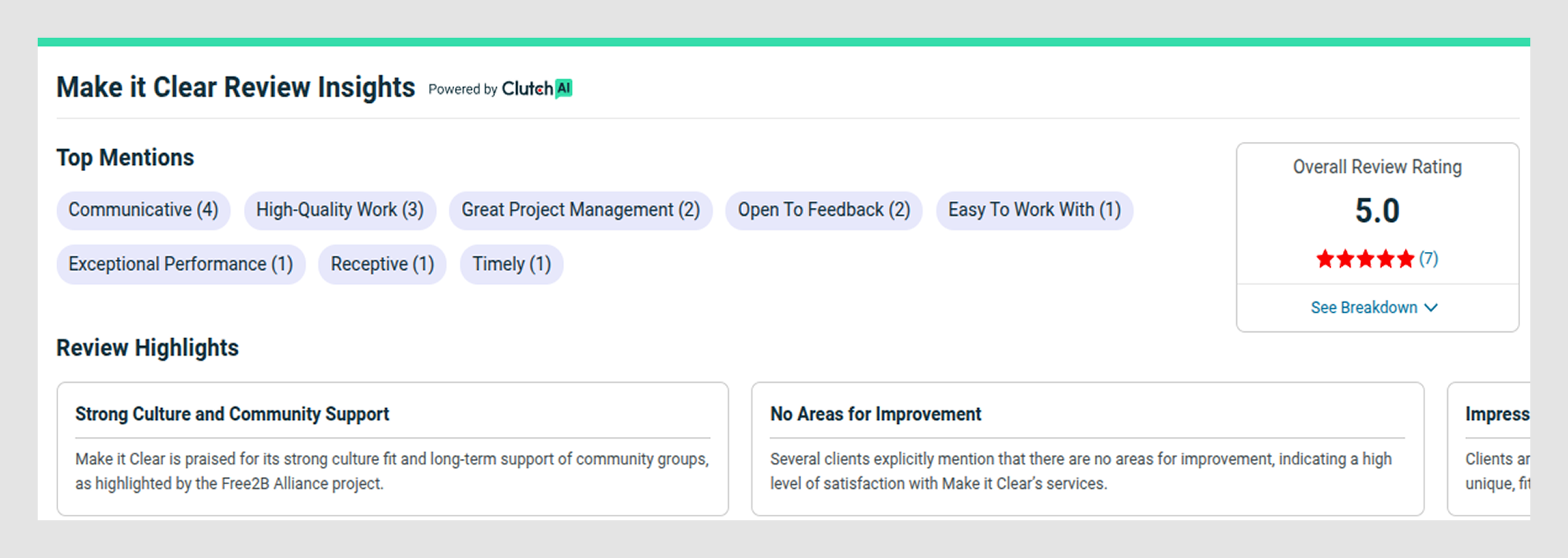
Clients say Make it Clear lives up to the name when it comes to making big, messy user journeys digestible for users and stakeholders alike. The design team is easy to work with and pleasant.

Strong points
✔️ Clarity-driven design, great for education, policy, and tech tools.
✔️ Deep research capability.
✔️ Works well in multi-stakeholder environments.
✔️ Clear process with real deliverables (not just theory).
Weak points
– Not the flashiest visual design, clarity > aesthetics.
– Better for B2B or service UX than trendy consumer apps.
What makes them different
- They do real UX research, not just a survey and a hunch.
- Great for simplifying complex or regulated content.
- Trusted by institutions and scale-ups who value precision.
7. Ustwo Studio

If you want pixel-perfect UX and a side of design fame, ustwo is probably already on your radar.
They’re the studio behind Monument Valley. The company has evolved into a heavyweight digital product partner for major brands. With a London HQ and global reach, ustwo balances imaginative design with enterprise execution.
Services: UX/UI design, product strategy, service design, digital transformation, prototyping, mobile app design.
Budget fit: £75K+ project minimum. Premium pricing to match their portfolio and scale.
Collaboration style: Cross-functional teams with researchers, strategists, and designers. London-based but comfortable leading fully remote.
Team size: 200+ across multiple studios (London, Malmö, NYC, Lisbon).
They’re a strong choice if your team needs bold thinking and big delivery. Think less “make it look better,” more “let’s rethink the whole experience.”
What clients say
ustwo has worked with Google, Ford, Soni, and BMW Group, alongside large NGOs and health organizations, with a Clutch rating of 4.5.

Clients say they work quickly and bring energy, polish, and process, with a strong push toward user needs, not just stakeholder wishes.

Strong points
✔️ Enterprise-ready, great for scale, systems, and governance.
✔️ World-class design craft.
✔️ Ideal for brands with ambition and complexity.
✔️ Strong research, concept testing, and cross-disciplinary collaboration.
Weak points
– Budget and timeline may stretch smaller teams.
– You’re working with a large org, expect a bit more overhead.
What makes them different
- They blend playfulness with enterprise UX, a rare combo.
- Huge experience with digital transformation and product strategy.
- Great for orgs looking to do something brave, not just “optimize”.
8. Foolproof
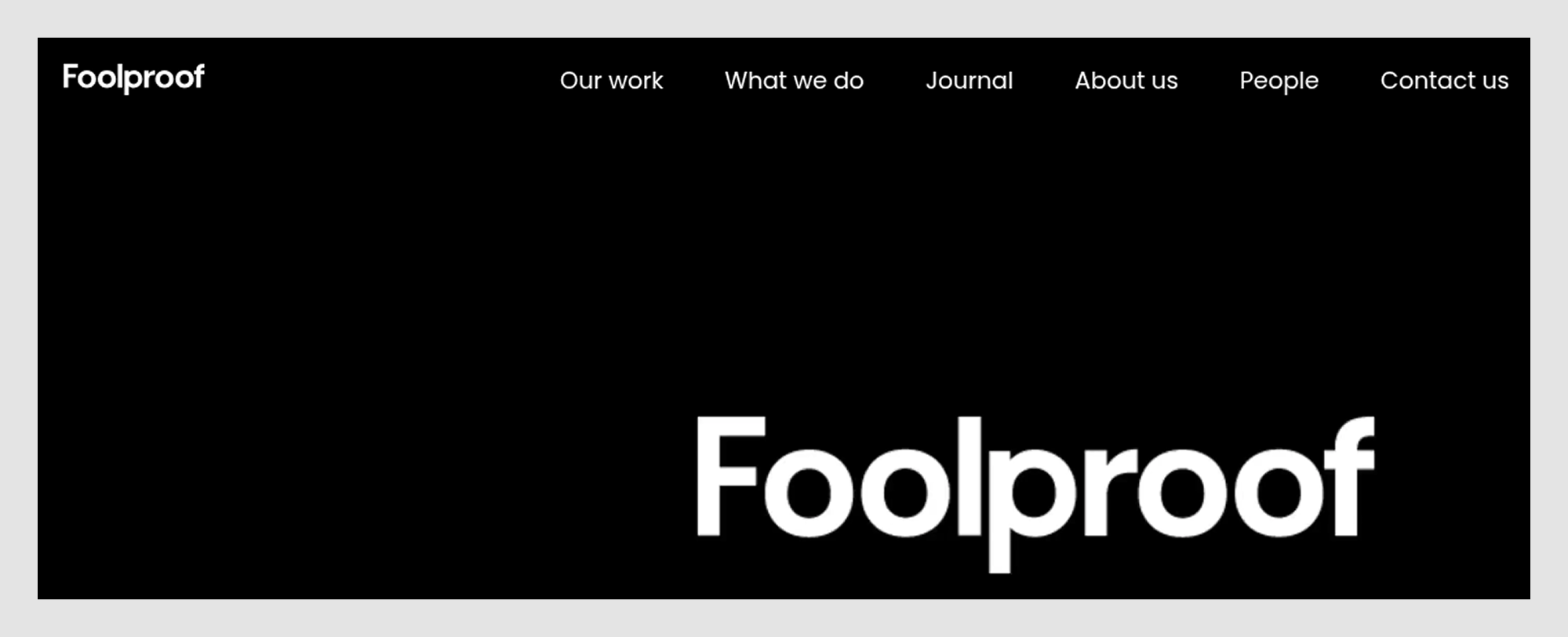
Foolproof is for teams with big ambitions, legacy systems, and a board that expects results.
They’re a mature UX and service design agency and a UX service design consultancy London with a serious track record. Owned by Zensar (a global IT powerhouse), Foolproof combines deep user insight with the ability to operate inside large, complex organizations.
Services: UX research, UI design, service design, digital product strategy, experience transformation, accessibility.
Budget fit: £100K+ project minimum. Enterprise-level budgets and longer engagements.
Collaboration style: High-touch and structured. Includes cross-functional teams (researchers, designers, strategists, accessibility UX experts).
Team size: 200+ across global locations; ~50 in London.
Their London team works across industries like finance, healthcare, and mobility, especially where UX is tied closely to business risk, compliance, or massive scale. If your product has a high learning curve, multiple personas, or tight regulations? This is your agency.
What clients say
Foolproof has worked with global brands like Shell, Microsoft, Suzuki, and Unilever. Known for playing the long game, they help organizations elevate their overall design maturity, not just patch isolated UX issues.
While they don’t have a Clutch rating, clients on Google praise their team: “I couldn’t have asked for a better bunch of people to work with.”

Strong points
✔️ Trusted by enterprises and highly regulated industries.
✔️ Robust accessibility and inclusive digital design practices.
✔️ Built for long-term partnerships, not one-offs.
✔️ Can plug into large internal teams and bring structure.
Weak points
– High entry cost.
– Less agile or startup-oriented, better suited for teams with an internal process.
What makes them different
- UX maturity model; they help teams grow, not just ship.
- Seamless collaboration with legal, compliance, and IT.
- Strong service design discipline for multi-touchpoint journeys.
9. Method

Method is where design meets business transformation, and both walk out more functional.
They’re a strategic UX and service design firm that works with Fortune 500s, legacy tech, and companies staring down a digital pivot. Based in London (with global reach), Method is best suited for enterprise teams that need more than UI tweaks; they need alignment, clarity, and a roadmap out of the complexity.
Services: UX and service design, customer journey mapping, digital strategy, experience transformation, innovation consulting.
Budget fit: £100K+ project minimum. Geared toward enterprise and global brands.
Collaboration style: Highly consultative, expect workshops, stakeholder facilitation, and multi-sprint planning. Hybrid remote + in-person (London office).
Team size: ~150 globally; core UK team of ~30.
If you’re dealing with disjointed user experiences, siloed systems, or a dozen internal opinions, Method brings the structure and leadership to make sense of it all.
What clients say
They’ve worked with Fish4Dogs, Farmplan, Edenhouse, and Eastnor Castle. This UX company London doesn’t have a Clutch rating but holds a 5-star rating on Google.
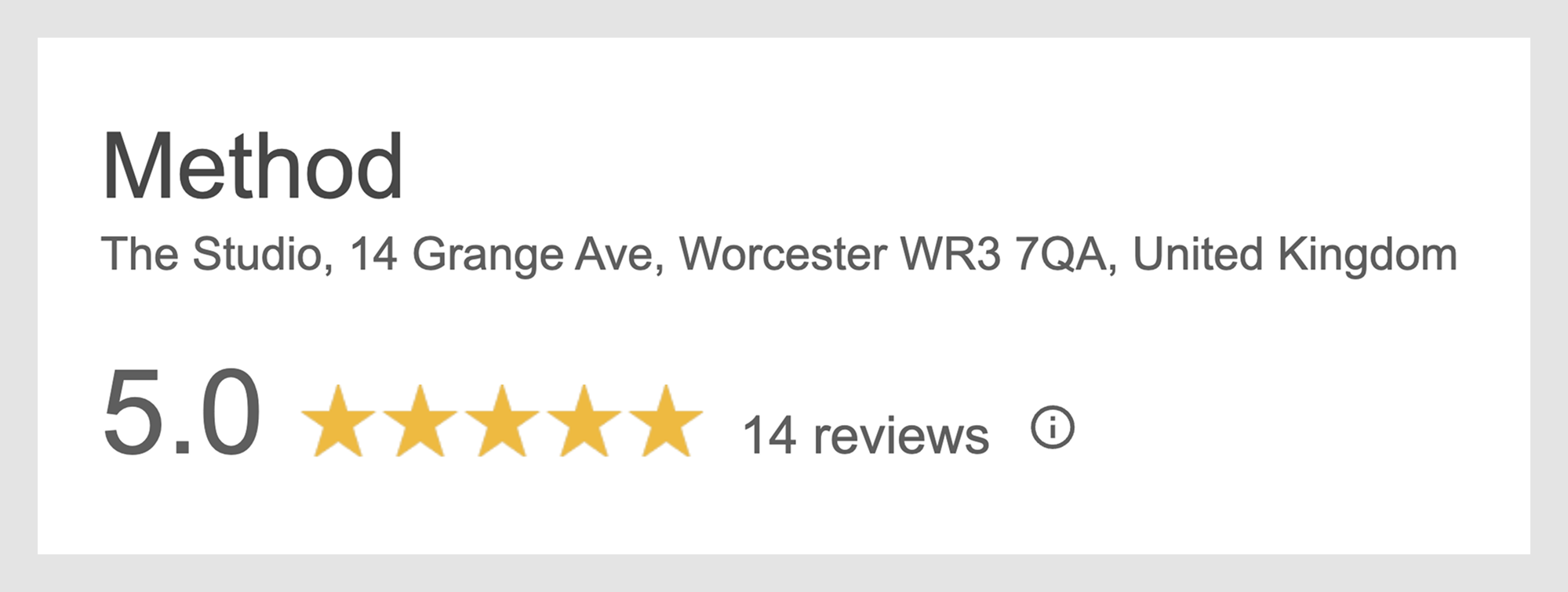
Clients trust them to lead design thinking across departments, not just improve wireframes, admitting that they are “really helpful and talented company”.

Strong points
✔️ Strong at aligning product, brand, and operations.
✔️ Ideal for experience overhauls and complex systems.
✔️ Enterprise fluency, they speak to stakeholders as well as users.
✔️ Capable of running parallel strategic and delivery tracks.
Weak points
– Too large/structured for lean MVPs.
– Focuses more on transformation than quick wins.
What makes them different
- Combines UX with systems thinking and org change.
- Great fit for multi-year digital roadmaps.
- Their strength is clarity when you’re buried in internal noise.
10. Super User Studio

Super User Studio isn’t flashy, and that’s kind of the point.
They specialize in UX for complex B2B SaaS platforms, where success looks like clarity, scalability, and user clarity.
Based in London, they work with enterprise product teams that are wrestling with data-heavy dashboards, workflows, and internal tools.
Services: UX research, enterprise UX design, design systems, product strategy, user modeling.
Budget fit: £50K+ project minimum. Long-term engagements and product partnerships.
Collaboration style: Hands-on and strategic. Often embedded with product teams over months, not a quick-hit agency.
Team size: Small, senior team (~10–15 experts).
This is a team that gets enterprise UX maturity. They won’t just redesign your interface. They’ll challenge your assumptions, your architecture, and your product vision. If you need high-level UX leadership with a laser focus on SaaS, they’re one of the strongest bets in the city.
What clients say
They’ve worked with Cloud8, Darwin, Capita, and B2B product teams across finance, security, and healthcare, and have a Clutch rating of 4.8.

Clients say they’re a thinking, detail-oriented partner, not just a design vendor. Expect tough questions and real rigor.

Strong points
✔️ Experts in B2B SaaS UX.
✔️ High UX maturity, good for scaling or replatforming products.
✔️ Deep systems thinking and long-term vision.
✔️ Not afraid to challenge your assumptions.
Weak points
– Not the agency for rapid MVPs or purely visual projects.
– Higher-touch engagements, you’ll need team time and buy-in.
What makes them different
- Laser focus on complex platforms, not shiny marketing pages.
- Design decisions backed by serious research and modeling.
- A rare mix of UX depth and long-term partnership mindset.
11. Creative Navy
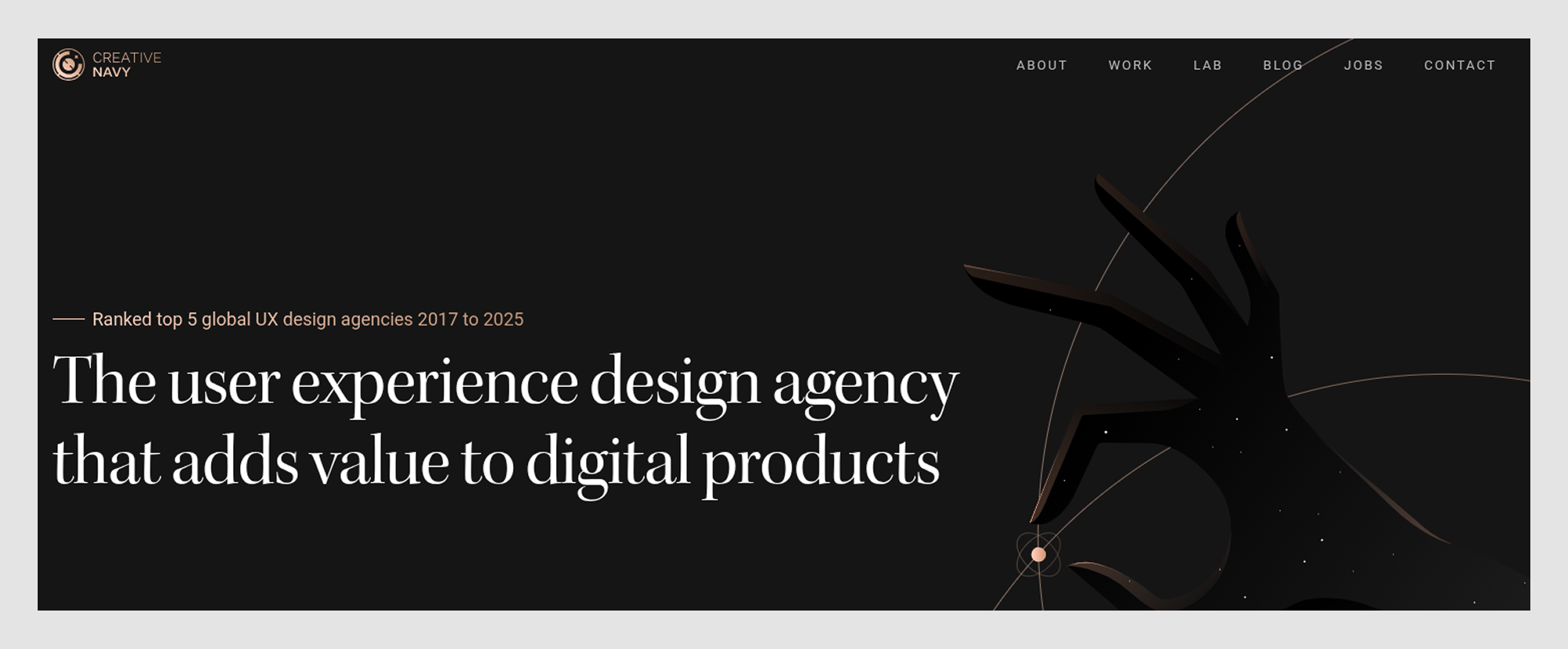
Creative Navy blends design with cognitive science, yes, really.
This UX agency London approaches interfaces like systems, not art projects. Their team includes designers, UX researchers, and cognitive scientists, which makes them uniquely suited for products that need to work under pressure: medical tools, automotive interfaces, and industrial dashboards.
Services: UX research, UI/UX design, human factors testing, prototyping, design systems, mobile and embedded UX.
Budget fit: £40K–£100K+. Regulated industry work typically requires more time, depth, and documentation.
Collaboration style: Structured and documentation-heavy. Focus on research, compliance, and design precision.
Team size: ~15–20 UX specialists and cognitive researchers.
They’re a strong fit if your product lives in a high-stakes environment where usability isn't optional; it’s regulatory. Think hospital software, vehicle infotainment, or complex diagnostic platforms.
What clients say
They’ve worked with Socar, Bosch, Philips, and European research labs. Their Clutch rating is 5.
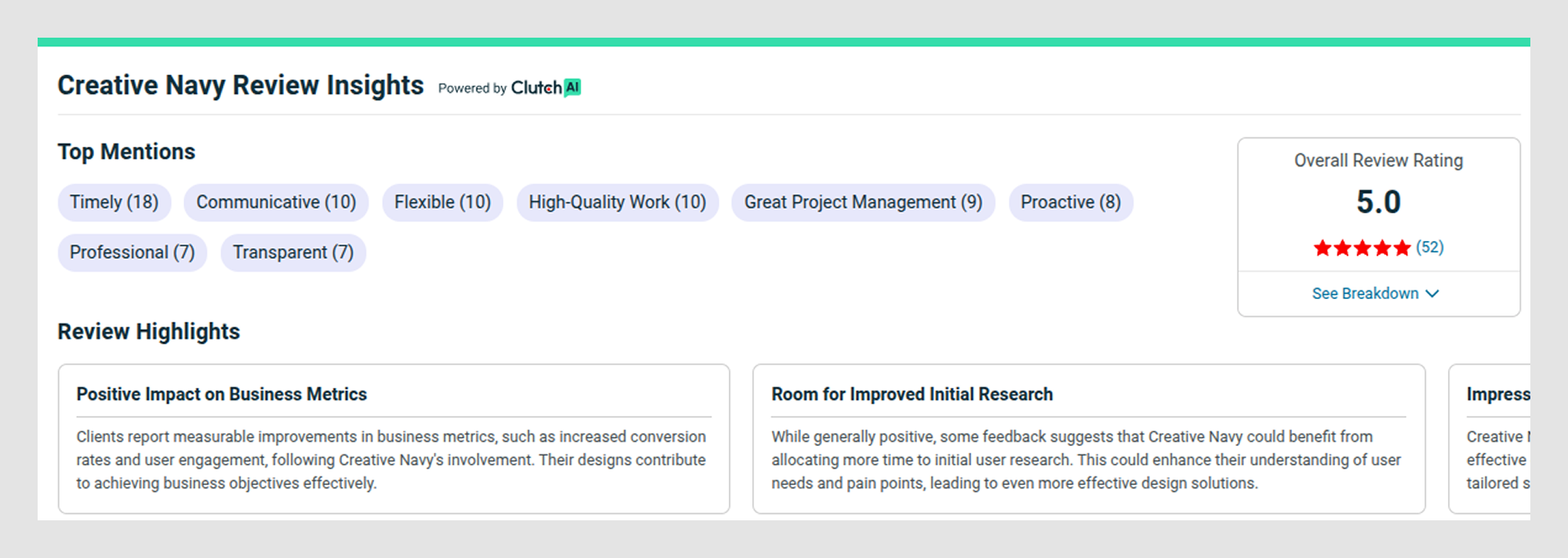
Clients highlight their ability to distill complex workflows into intuitive design solutions, especially for non-technical users under stress. The design team “demonstrates excellent project management”.

Strong points
✔️ Research-driven to the core.
✔️ Built for regulated, safety-critical, or industrial environments.
✔️ Precision-focused team with technical depth.
✔️ Strong documentation and usability testing practice.
Weak points
– Too structured for fast-moving consumer apps or MVPs.
– Higher cost for the level of rigor, and worth it if it’s mission-critical.
What makes them different
- The only UX design agency London on this list grounded in cognitive science.
- Design products people rely on in real-world, high-risk settings.
- Think like an engineer but deliver polished interfaces.
12. Pixelfield
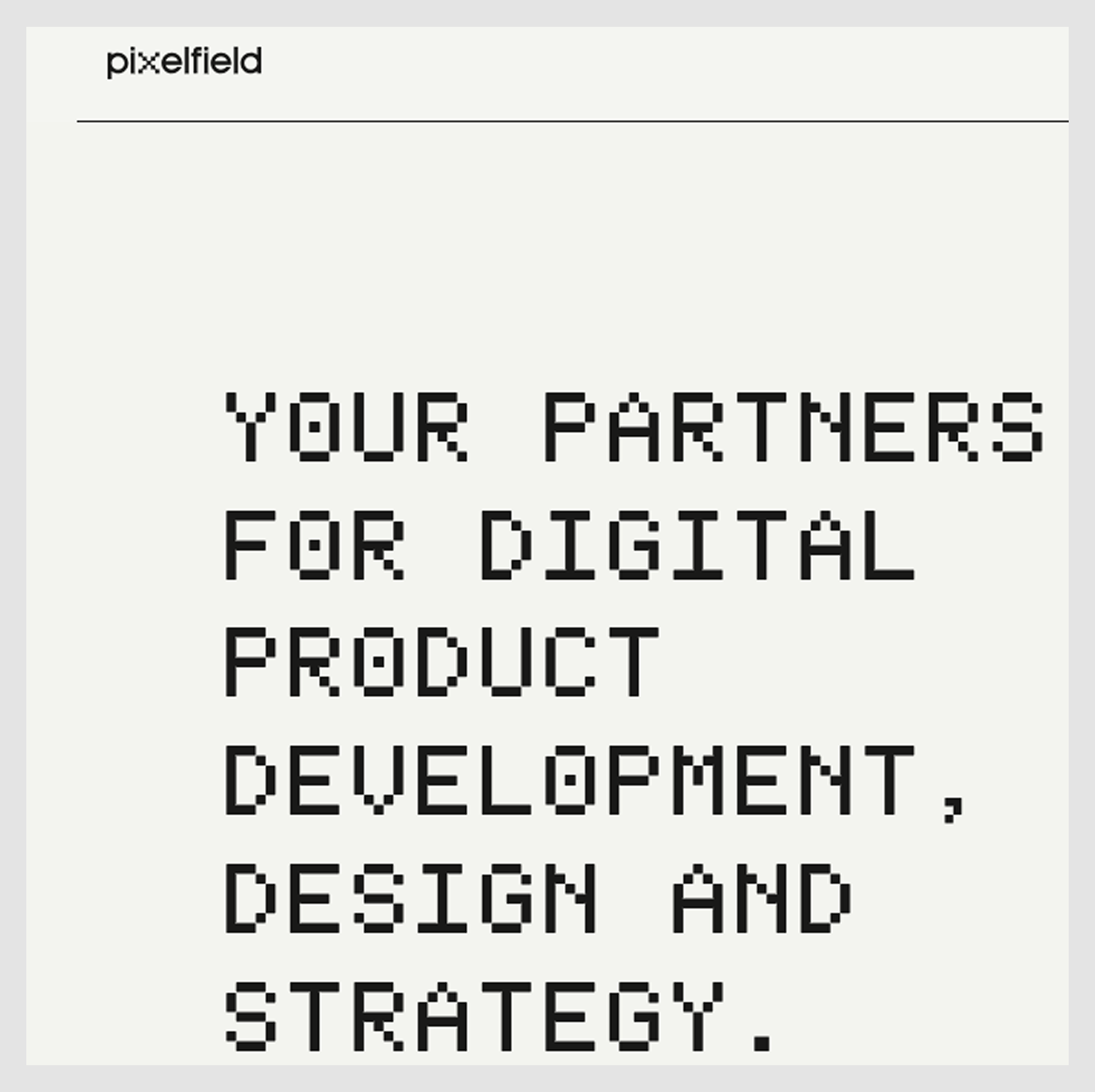
Pixelfield is a product design and development studio that feels like a startup, because they’ve helped launch so many.
Based in London and Prague, they offer full-cycle product design: from early workshops to MVP development. If you’re a startup founder looking for a partner who can both sketch and ship, Pixelfield fits the brief.
Services: UX/UI design, product strategy, MVP design + development, mobile/web app dev, design sprints.
Budget fit: ~£15K+ project minimum. Cost-effective for what you get, design + build under one roof.
Collaboration style: Agile and startup-aware. Often co-create with founders and product managers directly.
Team size: ~25 designers, devs, and product strategists.
They’re handy for teams who want to test ideas fast, run lean sprints, and build something real without blowing their first round of funding.
What clients say
They’ve worked with Lumyros, Veolia, and a wide range of startups across fintech, eComm, and edtech. Their Clutch rating is 5.
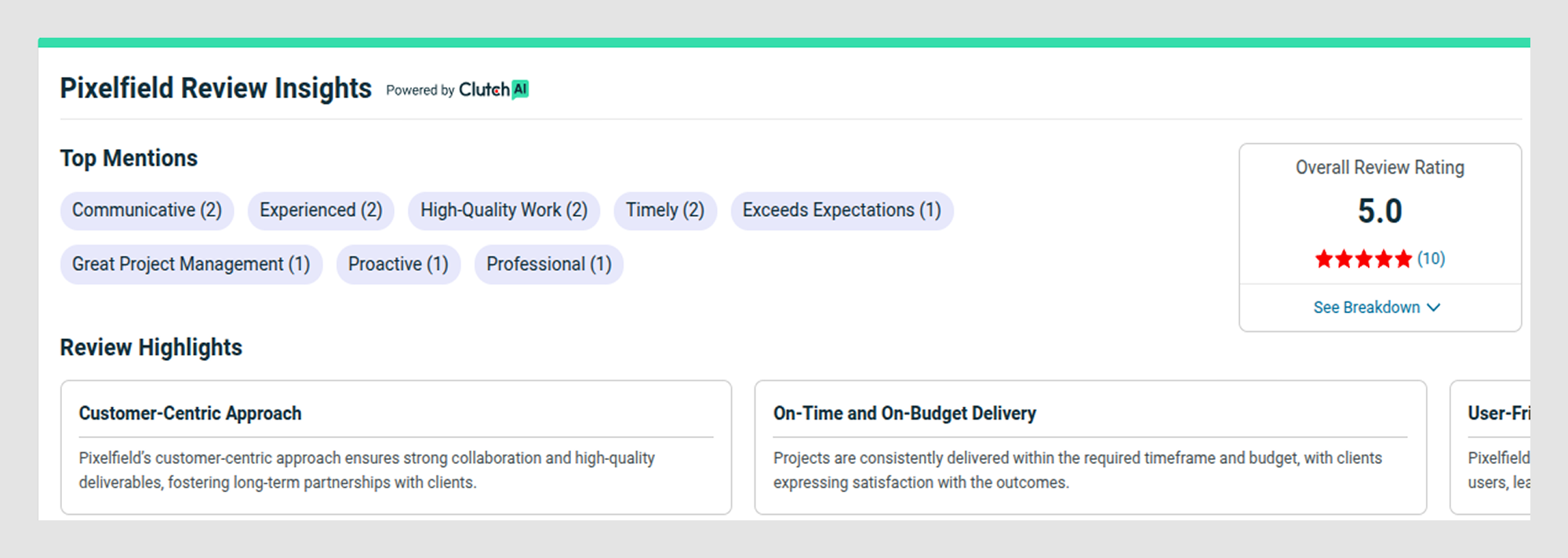
Clients appreciate not only their speed and structure, especially for MVPs and first product launches, but also as a valuable partner.

Strong points
✔️ One-stop shop: design + development.
✔️ Ideal for MVPs and early-stage startups.
✔️ Can move quickly from concept to live prototype.
✔️ Affordable without sacrificing quality.
Weak points
– Not built for long-term enterprise UX strategy.
– Less specialized in design-only (more of a product studio).
What makes them different
- They help founders get to market, not just make it look nice.
- Hands-on with both UX and development, less need to juggle vendors.
- Great choice if you need design and code on the same Slack thread.
13. Zero to Design
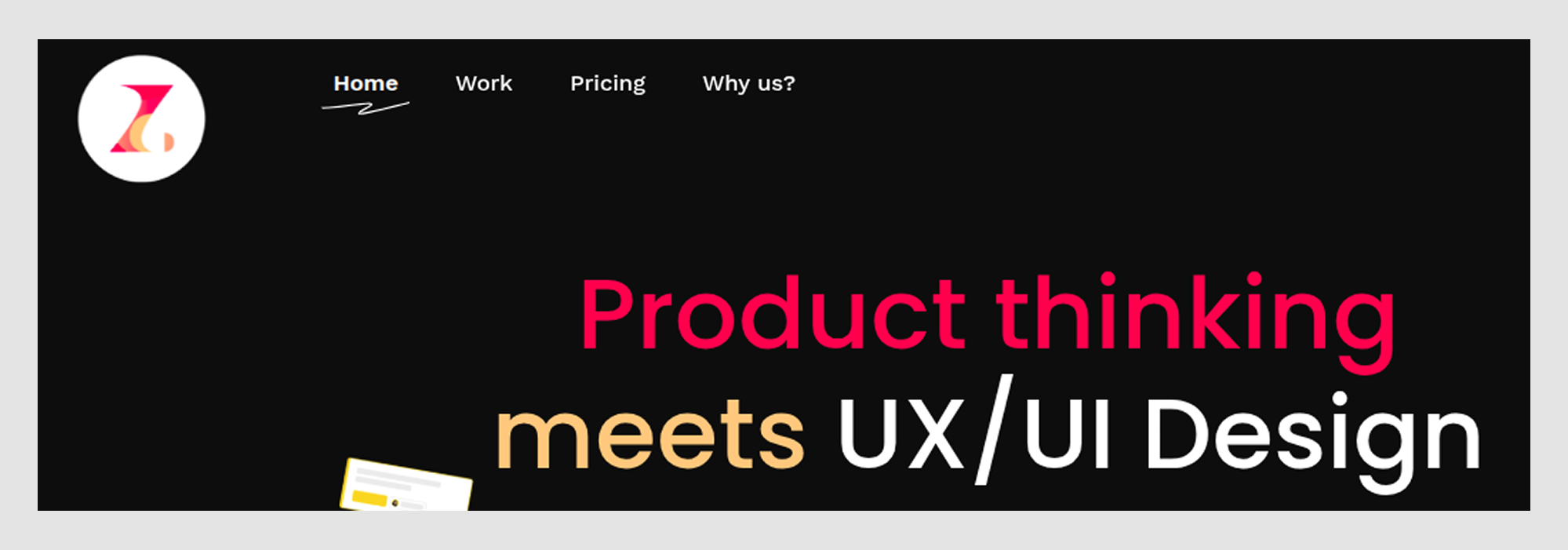
Zero To Design was built for startups, literally. Their entire model is tailored to early-stage companies that need UX support without the full-agency bloat.
You can hire them part-time or full-time, plug them into your Slack, and get moving. No giant proposals. No 6-week onboarding.
Services: UX/UI design, product UX, onboarding flows, design systems, embedded design support.
Budget fit: Flexible, part-time, or full-time designer subscriptions. Starts around £3–4K/month depending on scope.
Collaboration style: Remote, async-friendly. Designers embed directly in your product team.
Team size: ~10–12 product designers focused on startups.
They’re a great fit if you’re pre-launch, post-seed, or just need someone to bring UX sanity to a product that's growing fast and maybe breaking a little.
What clients say
Trusted by early-stage founders across fintech, SaaS, and marketplace startups, Zero To Design holds a 5-star rating on Clutch.
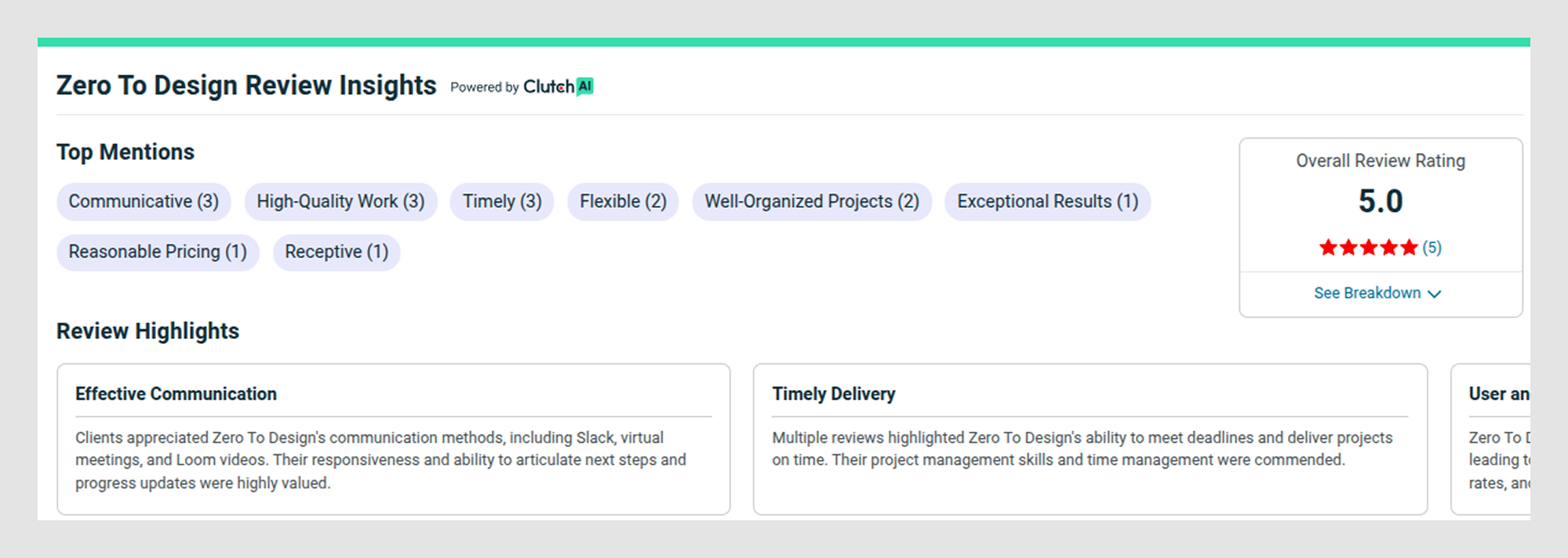
Clients praise the flexibility, especially for fast pivots, weekly releases, and growing product teams that aren’t ready for full-time hires.

Strong points
✔️ Built for startup realities: speed, flexibility, budget awareness.
✔️ Embedded model, you get a designer, not an “account lead”.
✔️ Great for post-seed product teams or UX revamps.
✔️ Can scale with you as your team grows.
Weak points
– Not structured for strategy-heavy work or enterprise stakeholders.
– Limited availability during peak demand.
What makes them different
- Hyper-focused on startup UX support.
- Subscription-style model that matches team growth.
- Ideal if you’re not ready to hire in-house, but need the same output.
14. Heer Digital

Heer Digital is a UX, web, and content agency that feels tailor-made for ecommerce and lifestyle brands.
Based in London, they specialize in conversion-friendly design that doesn’t sacrifice brand personality. If your Shopify store needs a UX overhaul, or your DTC site feels a little too 2019, Heer is worth a look.
Services: UX/UI design, website design, ecommerce UX, content management, content strategy, conversion optimization.
Budget fit: ~£5K–£20K per project. Budget-friendly, especially for DTC brands.
Collaboration style: Collaborative and founder-facing. Typically remote, but based in London for in-person collabs.
Team size: Small (under 10), but focused and highly responsive.
They’re a lean team with a sharp eye for detail, and they’ve built a reputation for delivering polished, high-impact designs on startup budgets.
What clients say
Heer has worked with consumer brands in fashion, wellness, tech accessories, and retail, with a Clutch rating of 5.
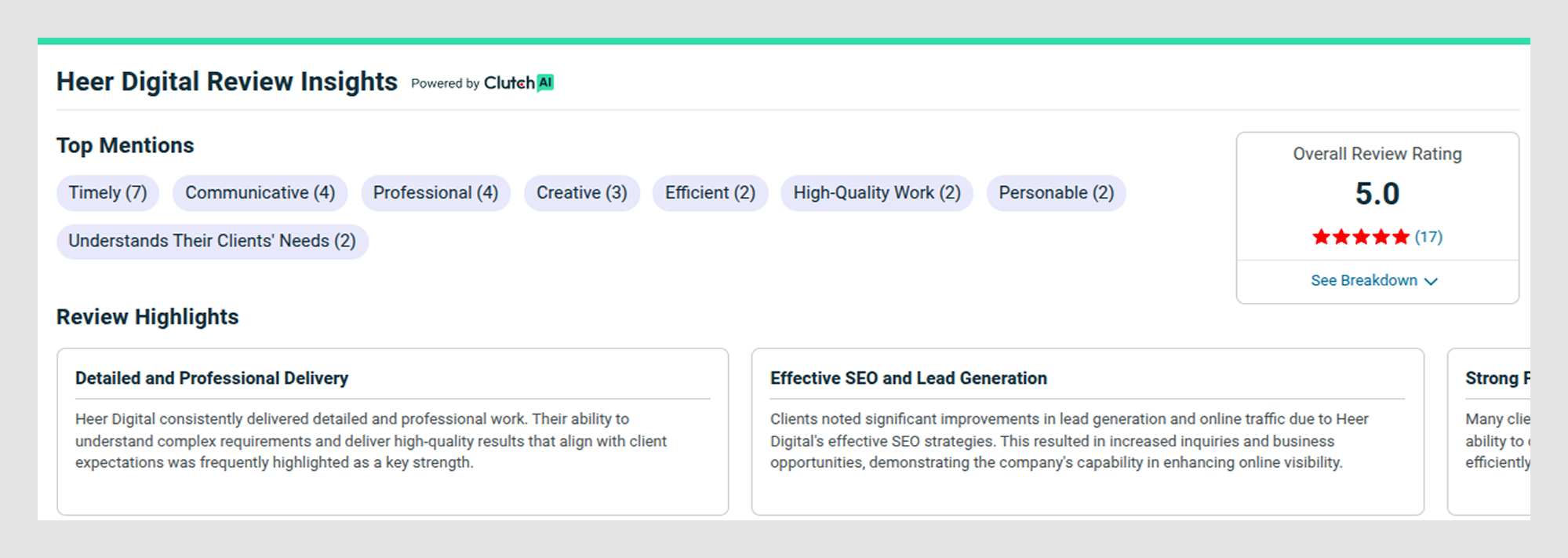
Clients love their attention to detail, quick turnaround times, and ability to “just get it” with minimal explanation.

Strong points
✔️ Strong visual and UX design for e-commerce.
✔️ Affordable, especially for early-stage DTC brands.
✔️ Fast and communicative, easy to work with.
✔️ Based in London and available for hands-on projects.
Weak points
– Not suited for complex platforms or deep research.
– Limited dev support, mostly design-focused.
What makes them different
- Tailored UX for Shopify, WooCommerce, and custom DTC.
- Great at balancing aesthetics with usability.
- A good fit if you want results without the agency drama.
15. Series Eight
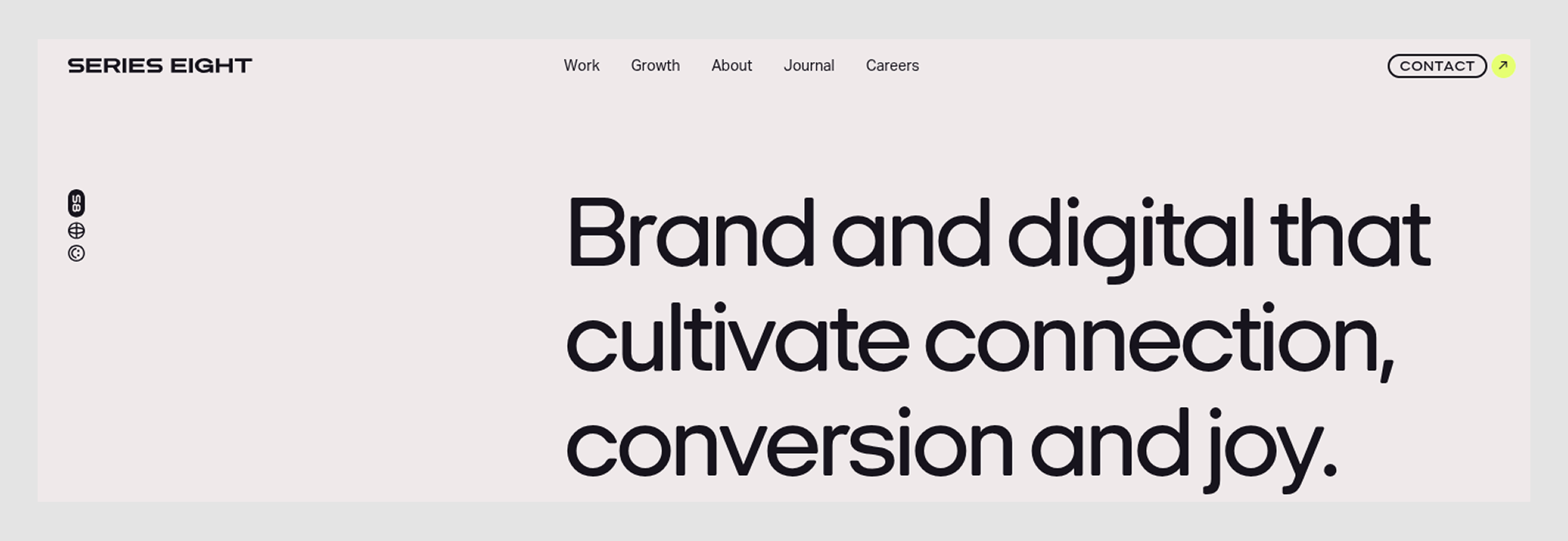
Series Eight builds slick digital experiences for lifestyle, fashion, and ecommerce brands, and they’ve got the awards to prove it.
Though they’re technically remote-first, they’ve got a strong London presence and frequently collaborate with UK-based DTC teams. Their style is clean, modern, and conversion-aware — ideal for brands that want to look polished without losing usability.
Services: UX/UI design, branding, ecommerce UX, web development, visual identity.
Budget fit: ~£15K–£60K+. Premium creative, but worth it for brand-forward sites.
Collaboration style: Remote-first with hybrid team availability. Strong async delivery + real-time design sessions when needed.
Team size: ~20+ designers, devs, and strategists.
This digital experience agency London is especially good at full redesigns: visual identity, UX flows, and development all under one roof.
What clients say
They’ve worked with Viatu, Acupanel, Aescape, and multiple lifestyle brands. The company holds a Clutch rating of 5.
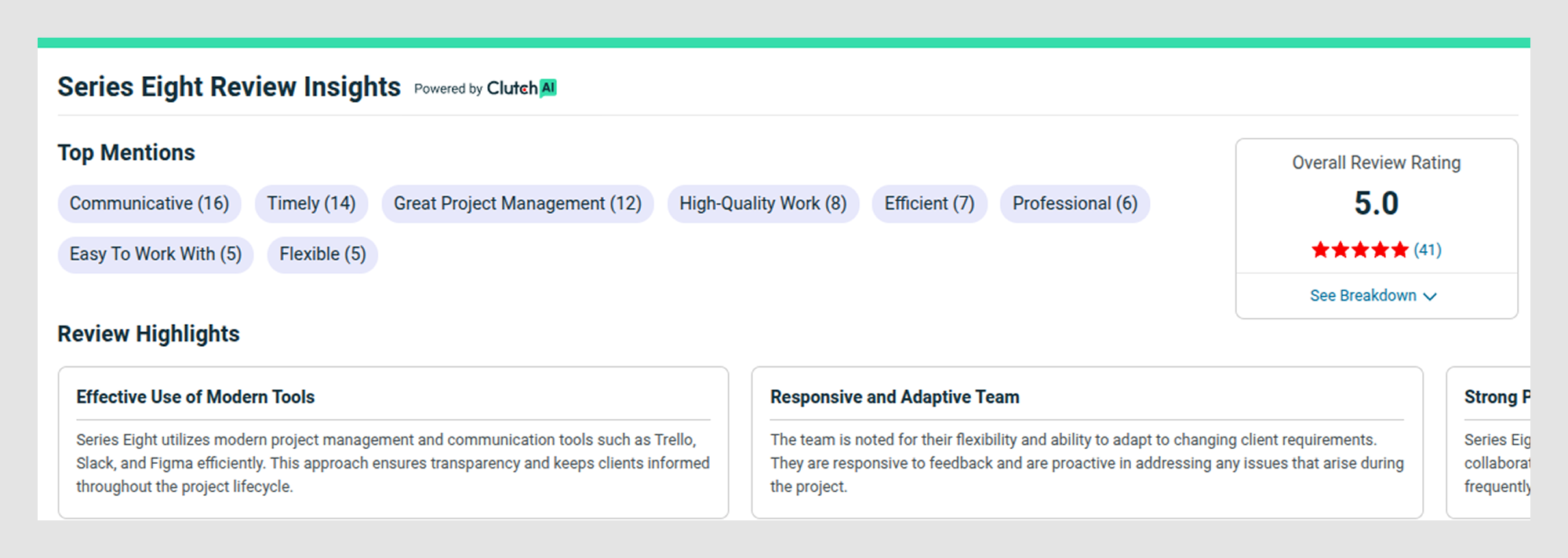
Clients rave about the blend of visual creativity and performance and how smooth the process is from kickoff to launch.

Strong points
✔️ Visually polished, conversion-focused ecommerce UX.
✔️ Branding and dev included, no need to juggle vendors.
✔️ Great for DTC, lifestyle, and creative-led brands.
✔️ Remote but well-versed in UK market needs.
Weak points
– Less suited for complex B2B products or SaaS.
– Not the cheapest, but you get premium polish.
What makes them different
- Beautifully executed ecommerce UX with real business outcomes.
- Strategic mix of brand, design, and functionality.
- A great choice if your product needs to look stunning and sell.
Compare UX design agencies in London
You’ve seen the agency details, now here’s the shortlist side by side. Use this to quickly spot who fits your project scope, budget, and industry.
How to choose the best UX agency in London
Not all agencies are built for the same kind of work. The best UX agency London partner for a B2B SaaS platform won’t be the best fit for a fashion e-commerce site, and that’s the whole point of this guide.
Here’s how to narrow your list and avoid expensive missteps.
Clarify your goals
What are you trying to accomplish?
- Launching a product? You’ll want speed and embedded collaboration, especially if you’re weighing the pros and cons of an in-house designer vs agency model. Leading UX design agencies like Eleken or Pixelfield offer flexibility that’s often ideal for UX design for startups.
- Redesigning an existing experience? Look for types of design agencies that focus on UX audits and iterative improvements (like Lighthouse or Super User Studio).
- Need branding and UX together? Series Eight can handle both.
- Fixing broken flows? Make sure the agency actually runs user testing and knows how to evaluate UX designers, not just polish buttons. If you’re new to the field and wondering what is UX design, start by learning how it goes far beyond visuals. It’s about usability, logic, and solving real user problems.
If your brief is fuzzy, get clear on what success looks like before you reach out.
Match by budget and scope
Some rough rules of thumb:

Tip: Avoid hiring a premium agency for a basic MVP and avoid going too lean for complex, stakeholder-heavy work.
This is also where understanding the differences between a UX designer vs product manager becomes important. If you need someone focused on user flows and usability, not just business strategy, make sure that’s built into the scope.
Think about the collaboration style
Do you want someone embedded in Slack with your team? Or do you want a polished process with milestone meetings and a UX consultant London?
- Embedded, async-first: Eleken, Zero to Design, Pixelfieldю
- Workshop-driven and structured: Foolproof, Method, or Lighthouse.
- Remote with London presence: Catch, Browser, Series Eight.
And if time zones matter to you, don’t worry. Most remote agencies on this list are well-versed in async tools, UK hours, and weekly standups.
Consider industry and UX maturity
Not all UX design agencies are suited for every industry. Your choice should reflect both the complexity of your product and your team’s UX maturity.
- E-commerce brand? You’ll want visuals and CRO. Go with Series Eight or Heer.
- SaaS platform? Prioritize flow logic, onboarding UX, and dashboards. Try Eleken or Super User Studio.
- Regulated or high-risk industry? You need rigor, think Creative Navy or Foolproof.
- Messy legacy product? You’ll want a calm partner who can handle complexity — Lighthouse or Method.
When you hire a designer or an entire agency, domain fit is often just as important as design skill.
Ask smarter questions
Here’s what to ask before you sign anything:
- Have you worked with companies like ours?
- Can I meet the people doing the work?
- How do you measure success beyond deliverables?
- Do you do real user research, or just surveys?
- How do you scope for projects that evolve mid-flight?
These are also key when learning how to hire UX designers, especially when your project’s success depends on usability, not just aesthetics.
Avoid agencies that sound overly rehearsed. A good partner will have clear, direct answers and be honest about what they’re not a fit for.
UX design pricing guide for London (2025)
UX agency pricing in London is all over the map. You’ll find everything from £3K/month embedded designers to £150K+ digital transformations with full research teams. So, how do you know what’s fair and what you’re paying for?
Here’s a breakdown.
What affects UX pricing?
A few key variables drive the cost:
- Depth of involvement: A quick UX audit is cheaper than a full redesign with dev handoff and testing.
- Research vs. execution: Research-heavy agencies (like Browser or Foolproof) cost more upfront, but save time later.
- Collaboration model: Embedded designers are cheaper than fully staffed agency teams.
- Output needed: Are you paying for wireframes, mockups, interactive prototypes, design systems, or all of the above?
Common pricing models
Different agencies use different pricing structures. Here are the most common ones and how they typically work.

Average price ranges (in GBP)
Here’s what you can expect to pay based on the scope of work and the stage your company is in.

For high-stakes projects, look for agencies that back their work with real outcomes. Some even share UX ROI case studies, which can help justify the investment and give you a clearer view of expected results.
How to get the most from your budget
No matter your budget, a few smart moves can help you stretch it further and get better results from your UX partner:
- Come with goals, not just vibes. The clearer your brief, the less time you waste.
- Start with a UX audit. It’s a low-risk way to test fit.
- Ask for async options. Remote/embedded agencies often give better value.
- Test before you commit. Some offer trials or design sprints (Eleken gives you 3 days free).
- Negotiate scope, not rates. Good agencies won’t slash pricing, but they will tailor deliverables.
Who’s the right UX partner for you?
There’s no single “best” UX agency in London. It all depends on what you’re building, how fast you need to move, and the kind of support your team needs.
But if you’re looking for:
- Designers who understand SaaS, product logic, and fast iteration;
- A lean process with no bloated strategy decks;
- Clear communication and embedded collaboration;
- Predictable pricing without long-term commitments.
Then, Eleken might be the most flexible and founder-friendly option on the list.
We’ve worked with dozens of UK startups and scale-ups looking to move fast, stay lean, and avoid the overhead of building an in-house design team.
With Eleken, you get direct access to a senior product designer, no account managers, no layers, just fast, focused UX support.
Want to see if we’re the right fit? Book a call, share your goals, and get early design concepts in just a few days with a free 3-day trial to start.
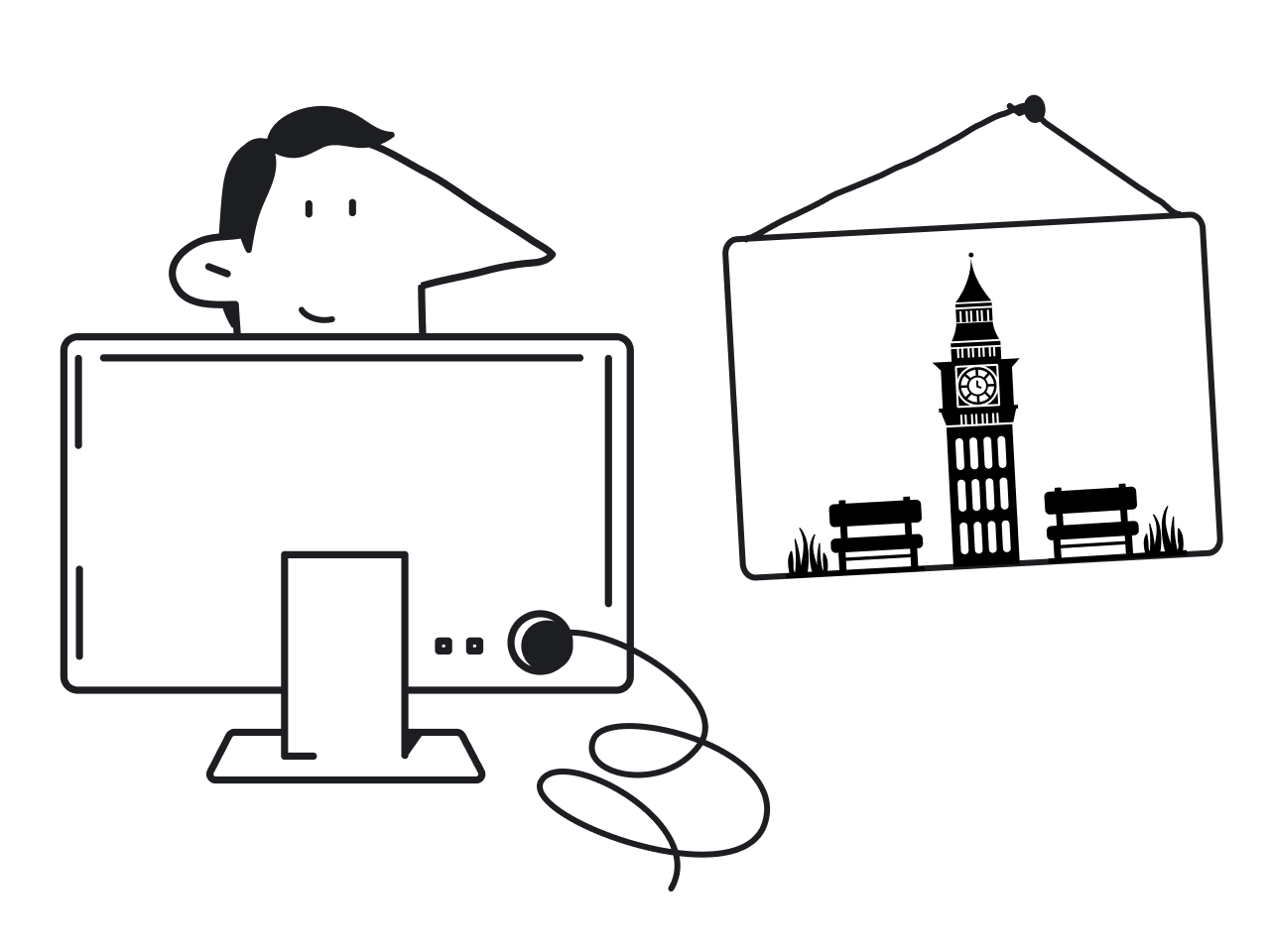





.webp)


.png)




